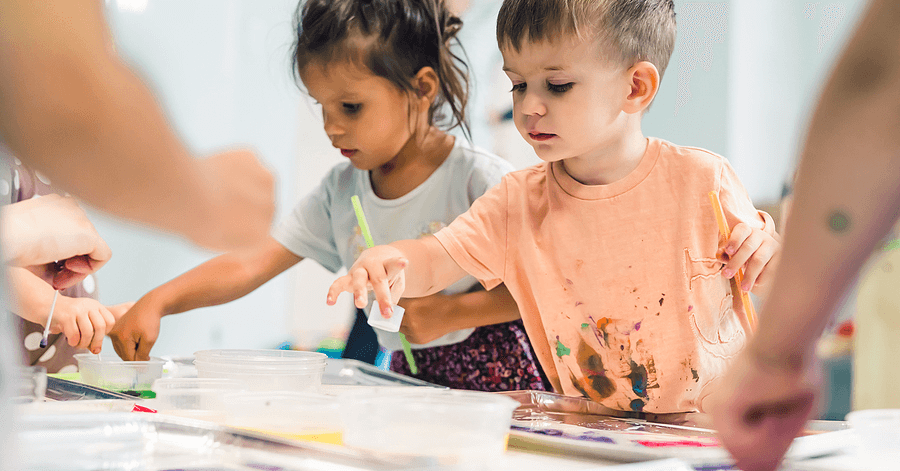How Artistic Expression Boosts Creativity and Problem-Solving in Children
In today’s fast-evolving world, creativity isn’t just an art—it’s a crucial life skill. For children, artistic expression plays a transformative role in developing not only imagination but also practical problem-solving abilities. In progressive schools across India, art is no longer just a hobby. It’s a foundation for creative learning, critical thinking, and emotional intelligence.
Why Artistic Expression Matters in Childhood Development
Children are natural explorers. Art, whether through drawing, painting, drama, dance, or music, offers a safe and joyful space for them to express feelings, test ideas, and build self-confidence.
Here’s how artistic expression enhances a child’s overall growth:
Boosts Creative Thinking:
Activities like storytelling or painting encourage children to think beyond the obvious, stimulating imagination and innovation.
Improves Problem-Solving Skills:
Artistic tasks often come without predefined answers. Children learn to evaluate, adapt, and solve problems creatively, whether it’s mixing colors or building a sculpture.
Fosters Emotional Intelligence:
Artistic expression allows children to process and articulate emotions, improving self-awareness and empathy.
Enhances Focus and Patience:
Creative activities involve planning, attention to detail, and persistence, traits crucial to lifelong learning.
Builds Confidence Through Self-Expression:
When children create something unique, they gain a sense of achievement, strengthening their self-esteem.
The Role of Progressive Education in Nurturing Creativity
Modern progressive education understands that real learning goes beyond textbooks. Progressive schools in India are leading the shift towards holistic development by integrating arts into the curriculum.
Key elements of creative learning in progressive schools include:
Project-Based Learning:
Real-world problems are explored through art, science, and literature—encouraging creative thinking from multiple angles.
Cross-Disciplinary Integration:
Art is woven into core subjects, helping students connect abstract concepts with real experiences.
Flexible Classrooms:
Children are given the freedom to explore and choose creative mediums that resonate with them.
Teacher as a Facilitator:
Rather than dictating answers, educators guide children to discover their own solutions, a hallmark of joyful and independent learning.
How Joyful Learning Fuels Curiosity and Innovation
Joyful learning emphasizes enjoyment in the process of discovery. It helps children associate learning with pleasure rather than pressure.
Art plays a vital role in this approach:
Turns classrooms into imaginative spaces
Encourages exploration without fear of failure
Keeps children intrinsically motivated
Supports multiple intelligences and diverse learning styles
By incorporating music, drawing, storytelling, and performance, joyful learning fosters both happiness and high engagement in the classroom.
Long-Term Impact of Artistic Expression
The benefits of artistic expression extend well beyond childhood. Children who engage in creative practices:
Display enhanced communication skills
Adapt easily to change and ambiguity
Collaborate more effectively in team environments
Excel in professions requiring innovative thinking
In an age where creativity ranks among the most valued job skills, nurturing it early gives children a meaningful head start.
FAQs
Q1: How can parents encourage artistic expression at home?
Encourage unstructured play, provide diverse art materials, and celebrate your child’s efforts rather than just outcomes. Let them explore freely.
Q2: Are arts really necessary for academic success?
Yes. Studies show that children who engage in the arts perform better in reading, math, and science. Art improves concentration, memory, and problem-solving—core academic skills.
Q3: What if a child isn’t naturally artistic?
Art isn’t about perfection. It’s about expression. Every child has the potential to benefit from creativity, regardless of natural talent.
Q4: How do progressive schools in India support artistic development?
Progressive schools integrate art into daily learning, offer specialized programs, and foster environments that value creativity alongside academics.
Q5: Is creative learning suitable for all age groups?
Absolutely. From toddlers to teens, creative learning nurtures curiosity, adaptability, and emotional development at every stage.
Conclusion
Art is more than just expression—it's a gateway to creative learning, joyful discovery, and real-world problem-solving. When embraced early, it equips children with skills that serve them well beyond the classroom. That’s why progressive schools in India place a strong emphasis on fostering artistic abilities. For parents and educators, the goal is simple: let children create, explore, and thrive.

